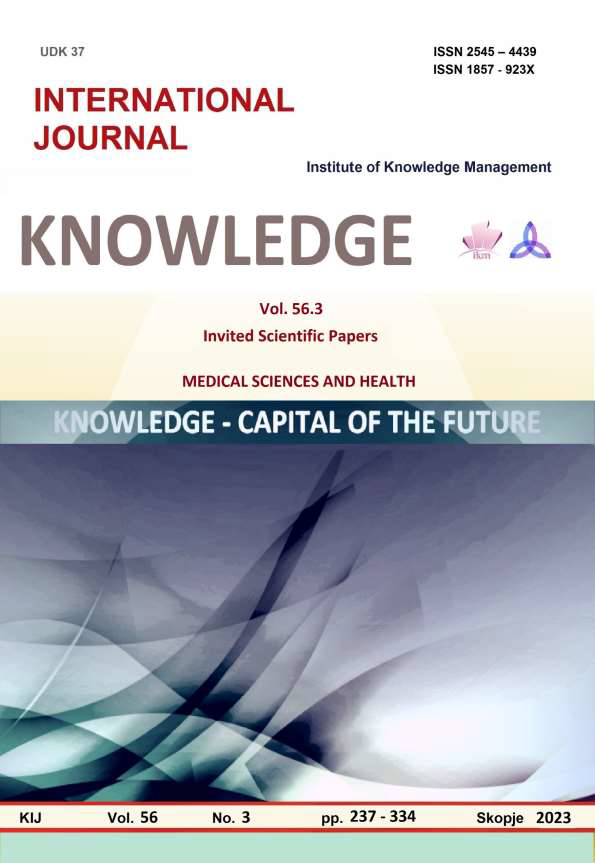miRNA AS A DIAGNOSTIC MARKER FOR CELL DIFERENTATION AND PROLIFERATION AND ALTERED GENE EXPRESSION
Keywords:
Micro RNA, molecular diagnostics, biomarkers, pathogenic diseases, micro RNA detectionAbstract
Micro RNAs (miRNA) are short non-coding RNA molecules that have an important regulatory role in
mRNA translation. More than 1000 different miRNA molecules have been detected in humans, which are necessary
for many cellular processes. Different expressions of miRNAs are specific to individual tissues and are associated
with a variety of pathological diseases. These properties make miRNA a potential and non-invasive diagnostic
research biomarker. Aims of the study: To emphasis the improvement and needs of expression analysis of miRNA
as a potential non-invasive diagnostic and prognostic biomarkers. Material and methods: In this review article is
explain all the procedure, the advantages and disadvantages of the most common miRNA detection methods, and
highlights the lack of standardization in all steps of miRNA detection. Results and discussions: We compare and
explain main findings of different studies about the involvement of miRNAs in diseases that affect a large part of the
human population. Conclusions: As a consequence, and previously study’s findings human miRNAs are likely to be
very useful as biomarkers, especially for future cancer diagnostics, and are rapidly emerging as attractive targets for
disease intervention.
References
Biswas, S., Haleyurgirisetty, M., Lee, S., Hewlett, I., & Devadas, K. (2019). Development and validation of plasma miRNA biomarker signature panel for the detection of early HIV-1 infection. EBioMedicine. 42: 307–316.
Cao, Z., Zhang, N., Lou, T., Jin, Y., Wu, Y., Ye, Z., & Pan, J. (2014). microRNA-183 down-regulates the expression of BKCaβ1 protein that is related to the severity of chronic obstructive pulmonary disease. Hippokratia 2014, 18, 328–332.
Dong, E., Du, H., & Gardner, L. (2020). An interactive web-based dashboard to track COVID-19 in real time. Lancet Infect. Dis. 2020, 20, 533–534
Filipowicz, W., Jaskiewicz, L., Kolb, F.A., & Pillai, R.S. (2005). Post-transcriptional gene silencing by siRNAs and miRNAs. Current Opinion in Structural Biology. 15(3):331-341.
Han, J. (2004). The Drosha-DGCR8 complex in primary microRNA processing. Genes &Development. 18(24):3016-3027.
Hanna, J.A., Wimberly, H., Kumar, S., Slack, F., Agarwal, S., & Rimm, D.L. (2017). Quantitative analysis of microRNAs in tissue microarrays by in situ hybridization. Biotechniques. 52: 235-245.
Hashimoto, T., Perlot, T., Rehman, A., Trichereau, J., Ishiguro, H., Paolino, M., Sigl, V., Hanada, T., Hanada, R.;, Lipinski, S., et al. (2012). ACE2 links amino acid malnutrition to microbial ecology and intestinal inflammation. Nature 2012, 487, 477–481.
Imai, Y., Kuba, K., & Penninger, J.M. (2008). The discovery of angiotensin-converting enzyme 2 and its role in acute lung injury in mice. Exp. Physiol. 2008, 93, 543–548.
Imai, Y., Kuba, K., Rao, S., Huan, Y., Guo, F., Guan, B., Yang, P., Sarao, R., Wada, T., Leong-Poi, H., et al. (2005). Angiotensin-converting enzyme 2 protects from severe acute lung failure. Nature 2005, 436, 112–116.
Inda Mandac Rongulj et al. (2020). SVEUČILIŠTE U ZAGREBU – MEDICINSKI FAKULTET.
Jiang, Z., Tao, J.H., Zuo, T., Li, X.M., Wang, G.S., Fang, X., Xu, X.L., & Li, X.P. (2017). The correlation between miR-200c and the severity of interstitial lung disease associated with different connective tissue diseases. Scand. J. Rheumatol. 2017, 46, 122–129.
Lee, R.C., Feinbaum, R.L., & Ambros, V. (1993). The C. elegans heterochronic gene lin-4 encodes small RNAs with antisense complementarity to lin-14. Cell. 75(5):843-854.
Lee, Y., Kim, M., Han, J., Yeom, K., Lee, S., Baek, S.H., & Kim, V.N. (2004). MicroRNA genes are transcribed by RNA polymerase II. EMBO J. 23(20):4051-4060.
Li, J. J., Huang, M. J., Li, Z., Li, W., Wang, F., Wang L., Li, X.L., Zheng, X., & Zou, Y. (2018). Identification of potential whole blood MicroRNA biomarkers for the blood stage of adult imported falciparum malaria through integrated mRNA and miRNA expression profiling. Biochem. Biophys. Res. Commun. 506: 471–477.
Lindner, K., Haier, J., Wang, D.I., Watson, D.J., Hussey, R. (2015). Circulating microRNAs: Emerging biomarkers for diagnosisand prog K. nosis in patients with gastrointestinal cancers. Clin. Sci. 2015,28, 1–15.
Liu, Q., Du, J., Yu, X., Xu, J., Huang, F., Li, X., Zhang, C., Li, X., Chang, J., Shang, D., et al. (2017). miRNA-200c-3p is crucial in acute respiratory distress syndrome. Cell Discov. 2017, 17021.
Lukas van de Sand , Peer Braß , Jonas Gregorius , Kevin Pattberg , Andrea Engler , Ulf Dittmer, Christian Taube , Stephan Brock , Marc Moritz Berger , Thorsten Brenner , Oliver Witzke, and Adalbert Krawczyk,(2022), Upregulation of miRNA-200c during Disease Progression in COVID-19 Patients/Journal of clinical medicine
Lyu L., Zhang X., Li C., Yang T., Wang J., Pan L., Jia H., Li Z., Sun Q., Yue L., Chen F., Zhang Z. (2019): Small RNA Profiles of Serum Exosomes Derived From Individuals With Latent and Active Tuberculosis. Front. Microbiol. 10: 1174.
Mitchell, P.S., Parkin, R.K., Kroh, E.M., Fritz, B.R., Wyman, S.K., Pogosova-Agadjanyan, E.L., Peterson, A., Noteboom, J., O’Briant,K.C., Allen, A., et al. (2008). Circulating microRNAs as stable blood-based markers for cancer detection. Proc. Natl. Acad. Sci. USA2008,105, 10513–10518.
Ramy, A., Korraaa, Y.E., Elsayeda, M. A., Abdelkadera, M.A., El-khazragyb, N. (2022), Role of miRNA-204 as a putative diagnostic marker in nonsmall-cell lung cancer/ Egyptian Journal of Chest Diseases and Tuberculosis 71(3):363
Ruvkun, G. (2001). MOLECULAR BIOLOGY: Glimpses of a Tiny RNA World. 294(5543):797-799.
Sodagar, H., Alipour, S., Hasani, S., Gholizadeh-Ghaleh Aziz, S., Khadem Ansari, M.H., & Asghari, R. (2022). The role of microRNAs in COVID-19 with a focus on miR-200c. J. Circ. Biomark. 2022, 11, 14–23
Van Rooij, E., & Olson, E.N. (2007). MicroRNAs: powerful new regulators of heart disease and provocative therapeutic targets. J. Clin. Invest.. 117(9):2369-2376.
Ye, J. et al. (2019). Journal of Pharmaceutical Analysis 9, 217e226
Yi, R. (2003). Exportin-5 mediates the nuclear export of pre-microRNAs and short hairpin RNAs. Genes & Development. 17(24):3011-3016.





